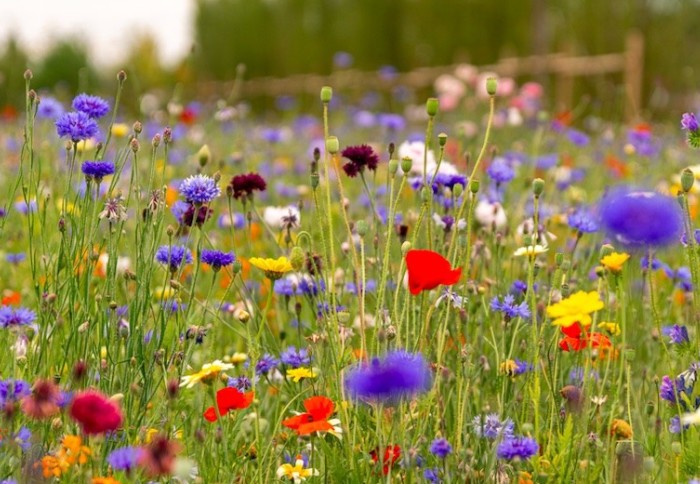We can’t tackle climate change if we ignore biodiversity

flowers for pollinators
The biodiversity crisis is as urgent as the climate crisis – and intimately interconnected, says Galina Jönsson.
Climate and biodiversity are interdependent, and both are in crisis. Tackling one without the other makes little sense then.
Yet policymakers (and even scientists) tend to forget this, resulting in climate policies that often fail to take account of biodiversity.
It’s a complex picture which needs a more holistic approach, says Galina Jönsson, an ecologist and Research Postgraduate in the Department of Life Sciences. We asked her to tell us more.

What are you researching?
The links between biodiversity loss and climate change, and what needs to be done to ensure that actions on one don’t negatively impact the other. Specifically, I’m looking at the impact of climate change and land-use change on butterflies in the UK. I’m based at the Natural History Museum in London, which has 500,000 butterfly specimens!
How can butterflies from the past, help us understand biodiversity now?
Butterfly/ natural history collections are a bit like biodiversity’s version of tree rings or ice cores. Butterflies are great ‘indicator species’ since environmental impacts trickle down to population changes/ responses very quickly. By looking at historical collections, we can see how environmental changes have impacted species over time.

What has biodiversity ever done for us?
Biodiversity underpins everything that makes life possible, and the health of our planet – not always directly, but certainly always indirectly. For example, we could not survive without trees to give us oxygen, aquatic ecosystems to purify our water, or soil microbes that recycle nutrients.
How serious is the biodiversity crisis?
Very. We are losing species and all facets of biodiversity, including species extinctions, genetic diversity and population sizes, at an unprecedented rate, at least since humans have been around.
One million animal and plant species globally are threatened with extinction because of human pressures, many within decades. The UK is one of the most nature-depleted countries in the world, with about half of its biodiversity left, far below the global average of 75% and the safe limit of 90%.

What is causing this?
There are many causes, but land-use change is currently the biggest driver of biodiversity loss globally. However, it’s predicted that climate change will soon become equally as devastating to biodiversity.
Humans have excessively altered 75% of land worldwide (with agriculture a key driver), and 40% of the oceans. Conversion of one land-cover to another, such as from forest to farmland, can remove entire ecosystems.
What impact is biodiversity loss having on humans?
Millions of people around the world are already affected by biodiversity loss. For example, degradation of mangrove forests increases vulnerability to extreme weather; reduction in fish populations impacts fishing communities; and a loss of pollinators affects crop yields. Then there are all the cultural, spiritual, and recreational, values that biodiversity holds for us all.
How are the climate crisis and biodiversity crisis linked?
It’s very important that we drastically cut GHG emissions, but it won’t be enough. We need to have a more holistic approach that understands the role biodiversity can play in climate action.
The biodiversity crisis and climate crises fuel each other. Biodiversity stabilises climate, since plants and trees capture and store GHGs. But it’s estimated that 1 in 6 species could go extinct from climate change globally.
Also, when a species goes extinct, or shifts its location, it interrupts interactions within the ecosystem – so a flower might lose its pollinator, or a predator its prey. We expect to start seeing entire ecosystems collapse, and with that the loss of carbon capture capacities, as well as the carbon stored in those ecosystems.

Could action on climate change or biodiversity, negatively impact the other?
Yes, it’s a big worry. Biodiversity is starting to be talked about more in climate change circles, but ecologists and climate scientists don’t always communicate enough/ effectively. For example, trees have been planted on natural grasslands and peatlands to capture carbon, but these soils are very carbon rich, so disturbing the soil releases carbon!
How can we tackle climate change and biodiversity loss together?
We need to explicitly align inter-government agendas on climate change and biodiversity loss, as well as have better cross-departmental cooperation on a national level, to make sure that actions that benefit climate change don’t harm biodiversity and vice versa.
We also need to remove financial incentives that encourage damage to nature, and ensure we don’t simply export our environmental damage abroad.
How do you feel about the future?
I feel optimistic that if we act now, we can still limit the catastrophic effect of climate change, to a point where human societies can adapt and thrive – but we are running out of time.
Article text (excluding photos or graphics) © Imperial College London.
Photos and graphics subject to third party copyright used with permission or © Imperial College London.
Reporter
Jez Fredenburgh
The Grantham Institute for Climate Change